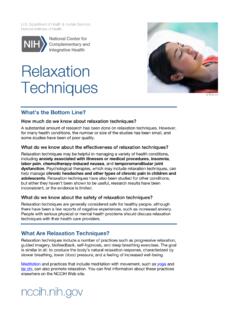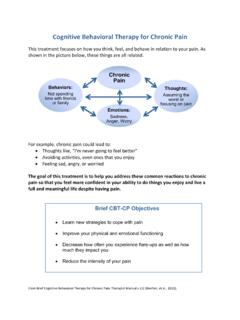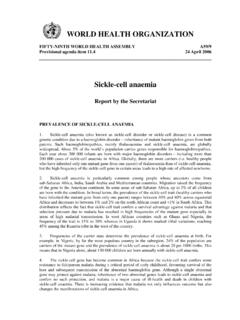Transcription of How to Document and Code for Hypertensive Diseases in …
1 How to Document and code for Hypertensive Diseases in ICD-10 THIS INSTALLMENT IN FPM S ICD-10 SERIES EXPLAINS THE GUIDELINES FOR CODING D. Beckman, MD, MBA, CPE, CPCA bout the AuthorDr. Beckman, a family physician, is vice president/chief medical officer for a health insurance company in Milwaukee, Wis. Author disclosure: no relevant financial affiliations from the Family Practice Management website at Copyright 2014 American Academy of Family Physicians. For the private, noncommercial use of one individual user of the website. All other rights reserved. Contact for copyright questions and/or permission requests. Because ICD-10 can be a distressing topic, let s start with some good news: Hypertension has a limited number of ICD-10 codes only nine codes for pri-mary hypertension and five codes for secondary hypertension.
2 This makes the task of coding hypertension relatively simple well, at least compared to some of the other ICD-10 positive change in ICD-10 is that the new code set drops the previous reference to benign and malignant hypertension. As physicians, we are well aware that hypertension is never truly benign, and the removal of this antiquated term is a welcome improvement in the lexicon of , of course, nothing is easy in ICD-10, and there are several things you need to be aware of before we dig into the codes themselves. For example, the Hypertensive disease codes in ICD-10 exclude several conditions: hypertension complicating pregnancy, neonatal hypertension, primary pulmonary hypertension, and primary and secondary hypertension involving vessels of the brain or the eye.
3 Postprocedural hypertension is also excluded from the secondary hypertension codes. In addition, you ll need to be careful throughout the Diseases of the Circulatory System chapter of ICD-10 to differentiate the capital I from the number 1. The hypertension codes span from I10 to I15 (there is no I14), and each series has its own peculiarities, as this article will (primary) hypertension: I10In ICD-9, essential hypertension was coded using (malignant), (benign), or (unspecified). ICD-10 uses only a single code for individuals who meet criteria for hypertension and do not have comorbid heart or kidney disease . That code is I10, Essential (primary) in ICD-9, this code includes high blood pressure but does not include elevated blood pressure without a diagnosis of hypertension (that would be ICD-10 code ).
4 If a patient has progressed from elevated blood pressure to a formal diagnosis of hypertension, a good documentation practice would be to include the reason for progressing the formal diagnosis. Similarly, a single mildly elevated blood pressure reading should be coded with the until the formal diagnosis is various sources define hypertension slightly differently, the provider should Document elevated systolic pressure above 140 or diastolic pressure above 90 with at least two readings on separate office visits. There are slight variations of this for older individuals and for individuals with readings obtained through ambulatory blood pressure monitoring. From a documentation viewpoint, it is only important that the provider clearly Document the basis for a newly established : Your patient, a 55-year-old female, has had blood pressure readings between 130-135/80-85 for several years.
5 At her annual examination, you record her blood pressure as 144/92 and 142/90. You discuss with her the importance of following up and schedule another appoint-ment for two weeks later. At that time, she again has several readings above 140/90, so you Document the progression from prehypertension ( ) to essential hypertension (I10).Hypertension and Hypertensive heart disease : I11 When an individual has hypertension and heart disease , it is up to the provider to determine whether there is a | 2causal relationship stated or implied. This rela-tionship determination is spelled out in the Offi-cial Guidelines for Coding and Reporting (draft 2014).1 The combination of hypertension and hyper-tensive heart disease is currently coded using the ICD-9 series of codes.
6 As noted earlier, each category is currently divided into malignant, benign, and unspecified essential hypertension with or without heart failure. In ICD-10, this is narrowed to only two base codes: , Hypertensive heart disease with heart failure, , Hypertensive heart disease without heart ICD-10 manual does not list the required documentation for Hypertensive heart disease . It is recommended, however, that the provider doc-ument the basis for the diagnosis (exam, electro-cardiogram, echocardiogram, etc.) at least the first time this diagnosis is made for the patient. It is not uncommon for patients with long-standing hyper- tension to develop some cardiac changes, but to code instead of just I10, the provider needs to Document the support for doing ICD-9, when you code hypertension with heart failure ( ) using ICD-10, you are required to also code the type of heart failure from the I50 series.
7 , Left ventricular failure, , Systolic (congestive) heart failure, , Diastolic (congestive) heart failure, , Combined systolic and diastolic heart failure, , Heart failure, you do not have a measurement of the left ventricular ejection fraction (typically from an echocardiogram), then you would need to use the more general left ventricular failure code ( ).The three codes for systolic, diastolic, and com-bined failure also require a fifth digit specifying the acuity of the diagnosis: 0, Unspecified, 1, Acute, 2, chronic , 3, Acute on : You have been following a 60-year-old male with hypertension and mild heart failure. You have coded and He recently had an acute exacerbation of his heart failure, was briefly hospitalized, and had an echocardiogram performed documenting combined systolic and diastolic failure.
8 At discharge, you update his diagnosis codes to and When you see him in the office two weeks post-discharge and he is asymptomatic, his diagnosis codes could be and reflecting the chronic nature of his and chronic kidney disease : I12 Unlike hypertension and heart disease , where the provider must determine whether a causal rela-tionship exists, if the patient has hypertension and develops chronic kidney disease , ICD-10 presumes a cause and effect relationship and classifies the condition as Hypertensive chronic kidney disease . Note, however, that if the chronic kidney disease came first, then the combination falls into the sec-ondary hypertension codes discussed later in this ICD-9 and ICD-10 require specifying the stage of the chronic kidney disease to properly code the condition.
9 Very few patients have a true glomerular filtration rate (GFR) measured and most staging relies on the estimated glomerular filtration rate (eGFR). Most laboratory reports provide a race-based reference range. It is not uncommon for these estimates to have slight variability and for the patient s staging to vary between stage 2 and 3. Note that ICD-10 differ-entiates stage 5 from end-stage renal disease by the need for chronic requires first using an I12 code for the combined diagnosis of hypertension and chronic kidney disease : , Hypertensive chronic kidney disease with stage 5 chronic kidney disease or end-stage renal disease , , Hypertensive chronic kidney disease with stage 1 through 4 chronic kidney disease or unspecified chronic kidney two codes require an additional N18 code to identify the stage of kidney disease , with documentation typically referencing the most recent eGFR.
10 , chronic kidney disease , stage 1,When you code hypertension with heart failure ( ) using ICD-10, you are required to also code the type of heart failure. ICD-10 includes nine codes for pri-mary hypertension and five codes for secondary hypertension. The code for essential (primary) hypertension, I10, does not include elevated blood pressure without a diagnosis of hypertension. There are just two base codes for patients with hypertension and heart disease : (with heart failure) and (without heart failure). | 3 , chronic kidney disease , stage 2 (mild), , chronic kidney disease , stage 3 (moderate), , chronic kidney disease , stage 4 (severe), , chronic kidney disease , stage 5, , End-stage renal disease , , chronic kidney disease , : You have been treating a 55-year-old black female for hypertension (I10) for the past five years.














